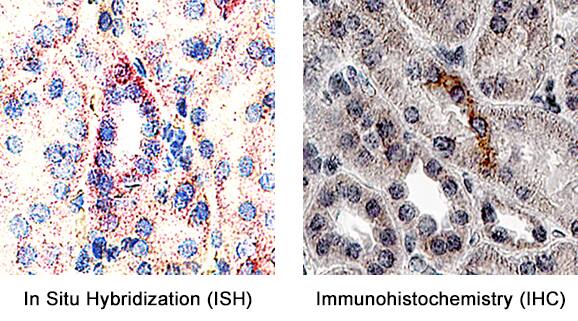Human TIM-1/KIM-1/HAVCR Antibody Best Seller
R&D Systems, part of Bio-Techne | Catalog # AF1750


Key Product Details
Species Reactivity
Validated:
Cited:
Applications
Validated:
Cited:
Label
Antibody Source
Product Specifications
Immunogen
Ser21-Thr288
Accession # Q96D42
Specificity
Clonality
Host
Isotype
Scientific Data Images for Human TIM-1/KIM-1/HAVCR Antibody
TIM‑1/KIM‑1/HAVCR in Human Kidney Cancer Tissue.
TIM-1/KIM-1/HAVCR was detected in immersion fixed paraffin-embedded sections of human kidney cancer tissue using Goat Anti-Human TIM-1/KIM-1/HAVCR Antigen Affinity-purified Polyclonal Antibody (Catalog # AF1750) at 1 µg/mL for 1 hour at room temperature followed by incubation with the Anti-Goat IgG VisUCyte™ HRP Polymer Antibody (Catalog # VC004). Tissue was stained using DAB (brown) and counterstained with hematoxylin (blue). Specific staining was localized to cancer cells. View our protocol for IHC Staining with VisUCyte HRP Polymer Detection Reagents.Detection of TIM-1/KIM-1/HAVCR in Human Kidney.
Formalin-fixed paraffin-embedded tissue sections of human kidney were probed for TIM1 mRNA (ACD RNAScope Probe, catalog #452148; Fast Red chromogen, ACD catalog # 322750). Adjacent tissue section was processed for immunohistochemistry using goat anti-human TIM1 polyclonal antibody (R&D Systems catalog # AF1750) at 1ug/mL with 1 hour incubation at room temperature followed by incubation with anti-goat IgG VisUCyte HRP Polymer Antibody (Catalog # VC004) and DAB chromogen (yellow-brown). Tissue was counterstained with hematoxylin (blue). Specific staining was localized to tubules.Applications for Human TIM-1/KIM-1/HAVCR Antibody
Dual RNAscope ISH-IHC Compatible
Sample: Immersion fixed paraffin-embedded sections of human kidney
Immunohistochemistry
Sample: Immersion fixed paraffin-embedded sections of human kidney cancer tissue
Western Blot
Sample: Recombinant Human TIM-1/KIM-1/HAVCR (Catalog # 1750-TM)
Human TIM-1/KIM-1/HAVCR Sandwich Immunoassay
Reviewed Applications
Read 1 review rated 4 using AF1750 in the following applications:
Formulation, Preparation, and Storage
Purification
Reconstitution
Formulation
*Small pack size (-SP) is supplied either lyophilized or as a 0.2 µm filtered solution in PBS.
Shipping
Stability & Storage
- 12 months from date of receipt, -20 to -70 °C as supplied.
- 1 month, 2 to 8 °C under sterile conditions after reconstitution.
- 6 months, -20 to -70 °C under sterile conditions after reconstitution.
Background: TIM-1/KIM-1/HAVCR
TIM-1 (T cell-immunoglobulin-mucin; also known as KIM-1 and HAVCR) is a 100 kDa, type I transmembrane glycoprotein member of the TIM family of immunoglobulin superfamily molecules (1-3). This gene family is involved in the regulation of Th1 and Th2-cell-mediated immunity. Human TIM-1 is synthesized as a 359 amino acid (aa) precursor that contains a 20 aa signal sequence, a 270 aa extracellular domain (ECD), a 21 aa transmembrane segment and a 48 aa cytoplasmic domain (4-6). The ECD contains oneV-type Ig-like domain and a mucin region characterized by multiple PTTTTL motifs. The mucin region undergoes extensive O-linked glycosylation. The TIM-1 gene is highly polymorphic and undergoes alternate splicing (1). For instance, the presence of a six aa sequence (MTTTVP) at position #137 of the mature molecule is associated with protection from atopy in people with a history of hepatitis A (7, 8). There are two cytoplasmic alternate splice forms of TIM‑1. One is a long (359 aa) kidney form termed TIM-1b, and one is a short (334 aa) liver form termed TIM-1a. Both are identical through the first 323 aa of their precursors. TIM-1b contains a tyrosine phosphorylation motif that is not present in 1a (6). TIM-1 is also known to circulate as a soluble form. Constitutive cleavage by an undefined MMP (possibly ADAM33) releases an 85-90 kDa soluble molecule (6). The ECD of human TIM-1 is 50% and 43% aa identical to mouse and canine TIM-1 ECD, respectively. The only two reported ligands for TIM-1 are TIM-4 and the hepatitis A virus (4, 9). However, others are believed to exist, and based on the ligand for TIM-3, one may well be an S-type lectin (10). TIM-1 ligation induces T cell proliferation and promotes cytokine production (1, 10).
References
- Meyers, J.H. et al. (2005) Trends Mol. Med. 11:1471.
- Kuchroo, V.K. et al. (2003) Nat. Rev. Immunol. 3:454.
- Mariat, C. et al. (2005) Phil. Trans. R. Soc. B 360:1681.
- Feigelstock, D. et al. (1998) J. Virol. 72:6621.
- Ichimura, T. et al. (1998) J. Biol. Chem. 273:4135.
- Bailly, V. et al. (2002) J. Biol. Chem. 277:39739.
- Umetsu, D.T. et al. (2005) J. Pediatr. Gastroenterol. Nutr. 40:S43.
- Gao, P-S. et al. (2005) J. Allergy Clin. Immunol. 115:982.
- Zhu, C. et al. (2005) Nat. Immunol. 6:1245.
- Meyers, J.H. et al. (2005) Nat. Immunol. 6:455.
Long Name
Alternate Names
Gene Symbol
UniProt
Additional TIM-1/KIM-1/HAVCR Products
Product Documents for Human TIM-1/KIM-1/HAVCR Antibody
Product Specific Notices for Human TIM-1/KIM-1/HAVCR Antibody
This product is covered by one or more of the following US Patents 7,300,652; 7,041,290; 6,664,385 and other US and foreign patents pending or issued.
For research use only
